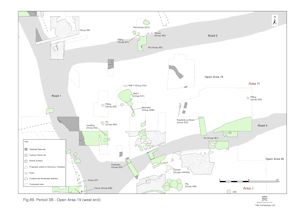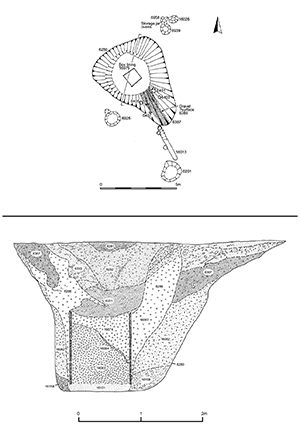
A late Period 3 development, presumably occurring once the second elliptical sub-enclosure and storage jar oven cluster passes out of use, is the insertion of a substantial well (Well 7) into the approximate centre of the west end of the enclosure in the mid-2nd century (Figure 89). In some respects, its imposition marks the onset of mid-Roman change within the western end of OA19.


Well 6280 consists of irregular oval construction cut 6280 with 'ramp' 6387 extending off it to the south-east (Figure 90). This ramp appears to be integral to the construction of this feature. A well at Stonea, Cambridgeshire, features a similar ramp (Jackson and Potter 1996, well 446, fig. 42, 101-2).
While the upper part of the construction cut has eroded or collapsed to produce a characteristic splayed irregular cone, the original profile of its lower portion remains as a circular vertical shaft some 1.8m diameter. Located at the centre of this shaft is a c. 1m square box-lining 16075, constructed of oak planks. One plank is particularly noteworthy for the bearing of a 'SV' stamp. The space between construction cut and wooden lining is backfilled with orange-brown clay deposit 16076.
Access ramp 6387 is lined with gravel (6386) and features an arrangement of four post- or stake-holes. As the ramp is apparently backfilled at the same time as the well cut, it would seem to have a purely constructional function; the post-settings possibly marking the position of something like a hoist frame.
Further infilling of the upper portion of the well construction cut is undertaken using rubbish-rich silt 6367 that may be derived from a pit or midden. Construction of the well is reliably dated to the mid-2nd century AD with the presence of a B2 dish in backfill deposit 16076. Dendrochronology gives a date for the timbers soon after AD 161, which would accord with this.
There is little to suggest the presence of a superstructure over or around the well. However, slot 16013 (Group 3008) immediately to its south, and seemingly aligned on its ramp, may constitute the foundation of some sort of related structure.
Subsequent use of the well is represented only by single accumulated fill 16131. This grey sandy silt contains only small quantities of pottery, tile and a lead weight (SF5668). A single tile tessera is judged to be intrusive from later infills. All later fills date firmly to Period 4.
In the south-western part of Open Area 19, dumping seals the former site of Building 16. Deposit 6380 (Group 533) is a very extensive and relatively deep (up to 0.4m) layer of silty sand build-up, with no real differentiation within it, and providing a remarkably level top surface, in contrast to everything below it. It was recorded over an area 9m by 5m but is certainly much more extensive. It contains a relatively small amount of finds for such a large volume, but includes mid-2nd century pottery (and much residual pottery), some tile, briquetage and a little animal bone. It should perhaps be viewed as a levelling deposit, although it is to the east of the line of Road 1, so it must be levelling the interior of OA19. It has been suggested above (see discussion of the fenceline in relation to Road 1 that this material is held in place by a revetment along its western boundary, which would make the corresponding phase of Road 1 run through a slight cutting here, for the only time in its life, before later phases rise up over the level of 6380 again. Deposit 6380 may build up behind a roadside fence (Group 364). While soils were accumulating on the roadway, they were also being eroded by the traffic using it, as demonstrated at the edge of deposit 6380.
Patchy gravels (6420 Group 509, Period 4: 6349, 6363, 6370, 6372, 6744, 6745, 16347 Group 510) lie on the on the northern edge of Road 4 (where they seal surface Group 381 and extend into the interior of Open Area 19. Such piecemeal resurfacing seems to continue as late as the mid-Roman period. The later maintenance is characterised by fragments of worn or degraded pebble surfaces (e.g., 6049, 6560 Group 522). It is possible that the distinction between road and off-road surfaces becomes significantly blurred; the roadside ditches are not renewed during this period, allowing road and interior surface to merge to form a more-or-less single surface.
Even allowing for the limited extent of investigation in Excavation Area H, mid-2nd century AD pits are clearly only occasional occurrences, the only excavated examples being small pit 6543 (Group 654), located to the south-west of the well, and 16066 (Group 532) just to its north.
Pit 6543 is notable for the inclusion of a clay block (SF8461), tentatively identified as an item of kiln furniture, along with over 1kg of other baked clay fragments. Pit 16066 (1m deep) contains only a quantity of tile in its single gravelly silt fill.
It is speculated that the appearance of well 6280, perhaps the product of increasingly public use of the west end of OA19, resulted in a decrease in the incidence of disposal.
Piecemeal resurfacing and patchy repairs to the gravel surfaces within Open Area 19, as investigated alongside Road 4, seems to continue into the mid- to later 2nd and perhaps early 3rd centuries.
This later maintenance (Group 516) is characterised by fragments of worn or degraded pebble surfaces (6090, 6148, 6219), some showing evidence of further repair (6278, 6279). Accumulated use silts 6287, 6289 (Group 514) overlie surface fragment 6148.
Storage jar oven 6456 is overlain by a patch of gravel 6452 (Group 502) that is presumed to represent Period 3B repair to the surviving Period 2B surface into which the oven is bedded - perhaps carried out once the oven became defunct in order to reinstate this part of the occupation surface. Oven 6551 is similarly sealed by the gravels 6523 (Group 500).
Post-holes of likely Period 3B date are present (Groups 513, 525, 534), though these do not show any meaningful patterning.
Internet Archaeology is an open access journal based in the Department of Archaeology, University of York. Except where otherwise noted, content from this work may be used under the terms of the Creative Commons Attribution 3.0 (CC BY) Unported licence, which permits unrestricted use, distribution, and reproduction in any medium, provided that attribution to the author(s), the title of the work, the Internet Archaeology journal and the relevant URL/DOI are given.
Terms and Conditions | Legal Statements | Privacy Policy | Cookies Policy | Citing Internet Archaeology
Internet Archaeology content is preserved for the long term with the Archaeology Data Service. Help sustain and support open access publication by donating to our Open Access Archaeology Fund.